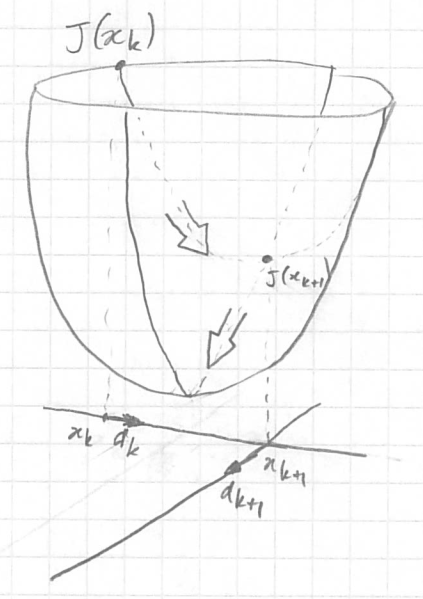The gradient method to solve A x = b¶
The goal of this lab is to let you move forward on your own. Look at previous course and program the gradient method to solve the $A {\bf x} = {\bf b}$ matrix system with A symmetric and diagonally dominant ($a_{ii} > \sum_{k \ne i} |a_{ik}|$).
- Start in 2D with a 2x2 matrix, check that the result is good and plot the convergence curve
- Switch to nxn (we will show that it works with a 9x9 matrix)
It may be interesting to normalize the matrix A to prevent the calculations from exploding.
def solve_with_gradiant(A, b):
mu = 0.01
import numpy as np
A = np.random.randint(10, size=(2,2))
A = A + A.T
A += np.diag(A.sum(axis=1))
A
array([[49, 13],
[13, 13]])
b = A.sum(axis=1)
b
array([62, 26])
solve_with_gradiant(A,b)
Introduce inertia¶
Introduce inertia into the gradient method. What do we notice?
Optimal value of µ¶
Note that two successive slope directions are orthogonal if the next point is the minimum in given direction ($\nabla J ({\bf x}^k$)).
$$\nabla J ({\bf x}^{k+1})^T \; \nabla J ({\bf x}^k) = 0$$
Demonstration¶
|
We want to adjust µ to arrive at the minimum of J when we advance in the direction $- \nabla J({\bf x}^{k})$.
This means that the partial derivative of $J({\bf x}^{k+1})$ with respect to µ must be
equal to 0 or by making µ appear in the equation:
$$ \frac{\partial J ({\bf x}^k - µ \; \nabla J ({\bf x}^k))}{\partial µ} = 0 $$ By expanding we have $$ \begin{align} \frac{\partial J ({\bf x}^{k+1})}{\partial {\bf x}^{k+1}} \; \frac{\partial {\bf x}^{k+1}}{\partial µ} & = 0 \\ J'({\bf x}^{k+1}) \, . \, (- \nabla J ({\bf x}^k)) & = 0 \\ (A\, {\bf x}^{k+1} - b) \, . \, \nabla J ({\bf x}^k) & = 0 \quad \textrm{since A is symetric}\\ \nabla J ({\bf x}^{k+1}) \, . \, \nabla J ({\bf x}^k) & = 0 \quad \textrm{QED} \end{align} $$ |

|
|---|
Using this property, evaluate the optimal value of µ to reach the minimum in the direction of $\nabla J ({\bf x}^k)$.
Write the gradient method with the calculation of the optimal µ at each iteration to solve $A {\bf x} = {\bf b}$.